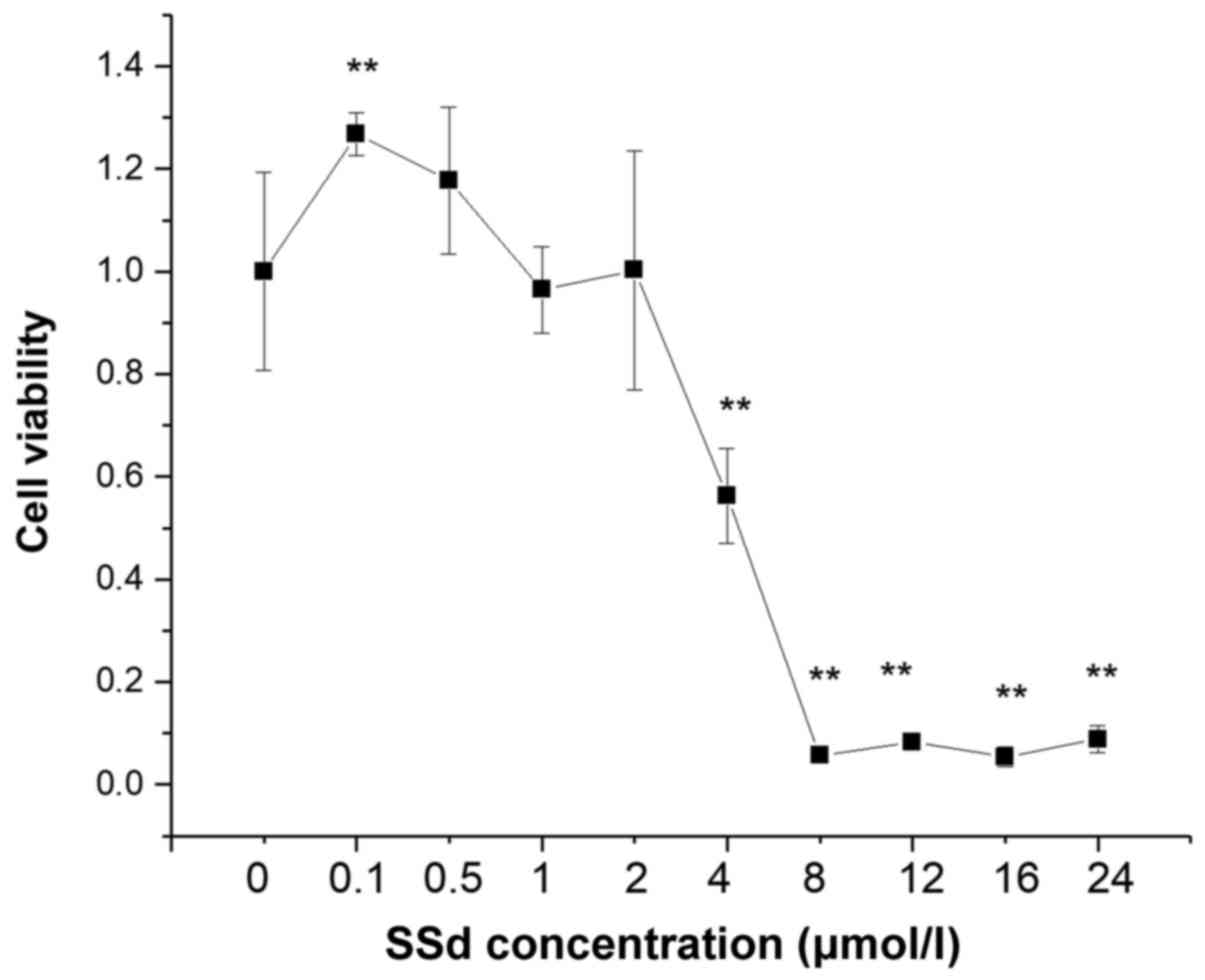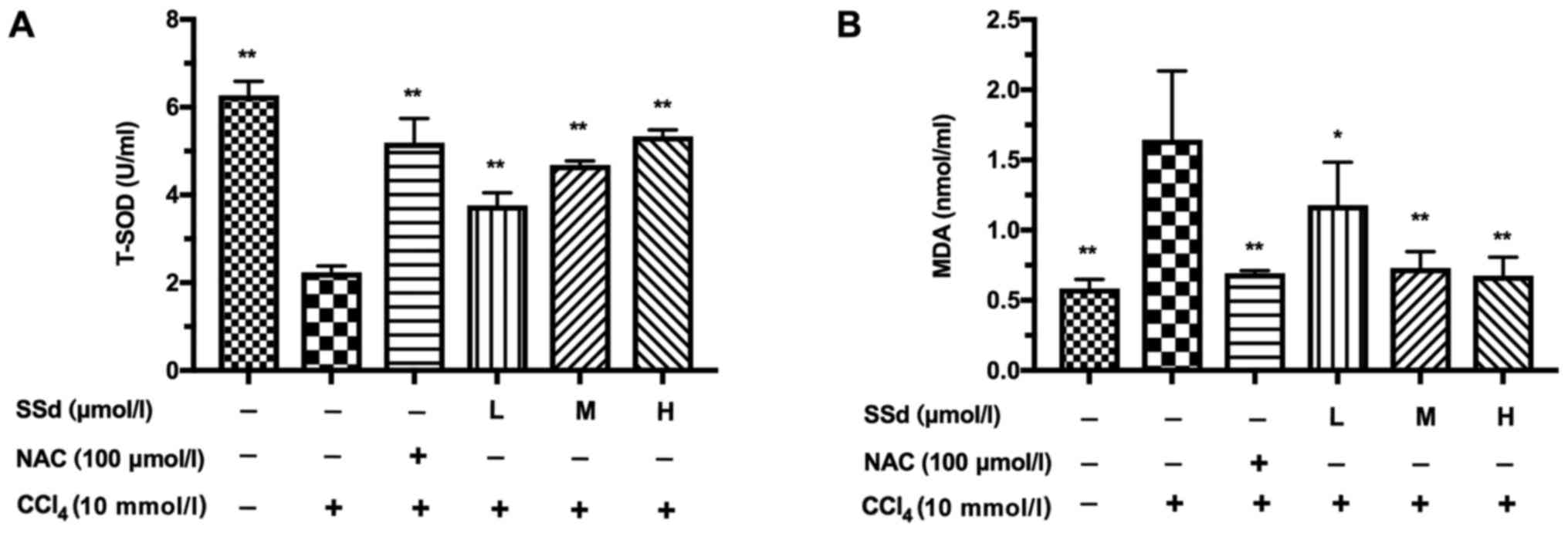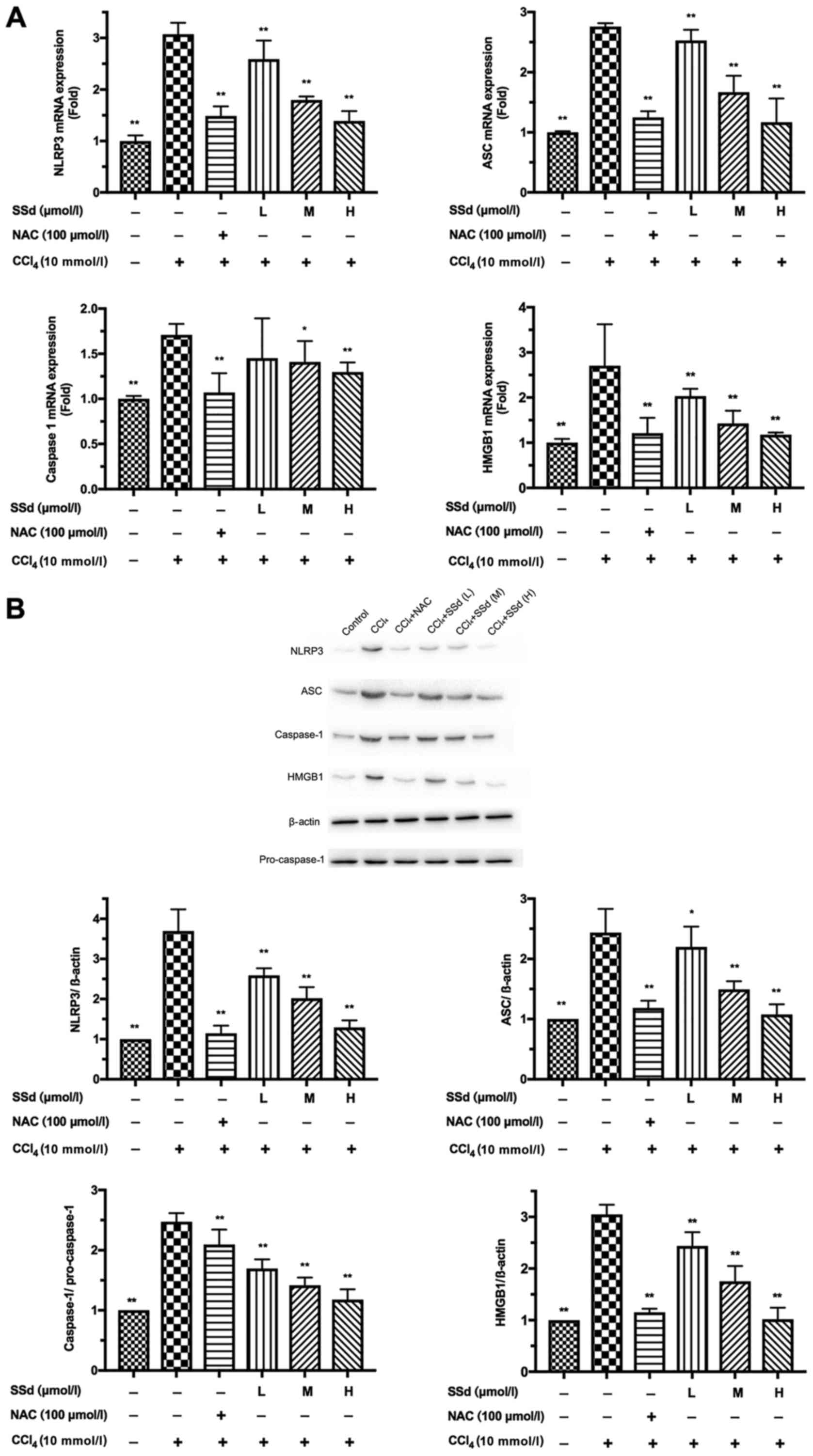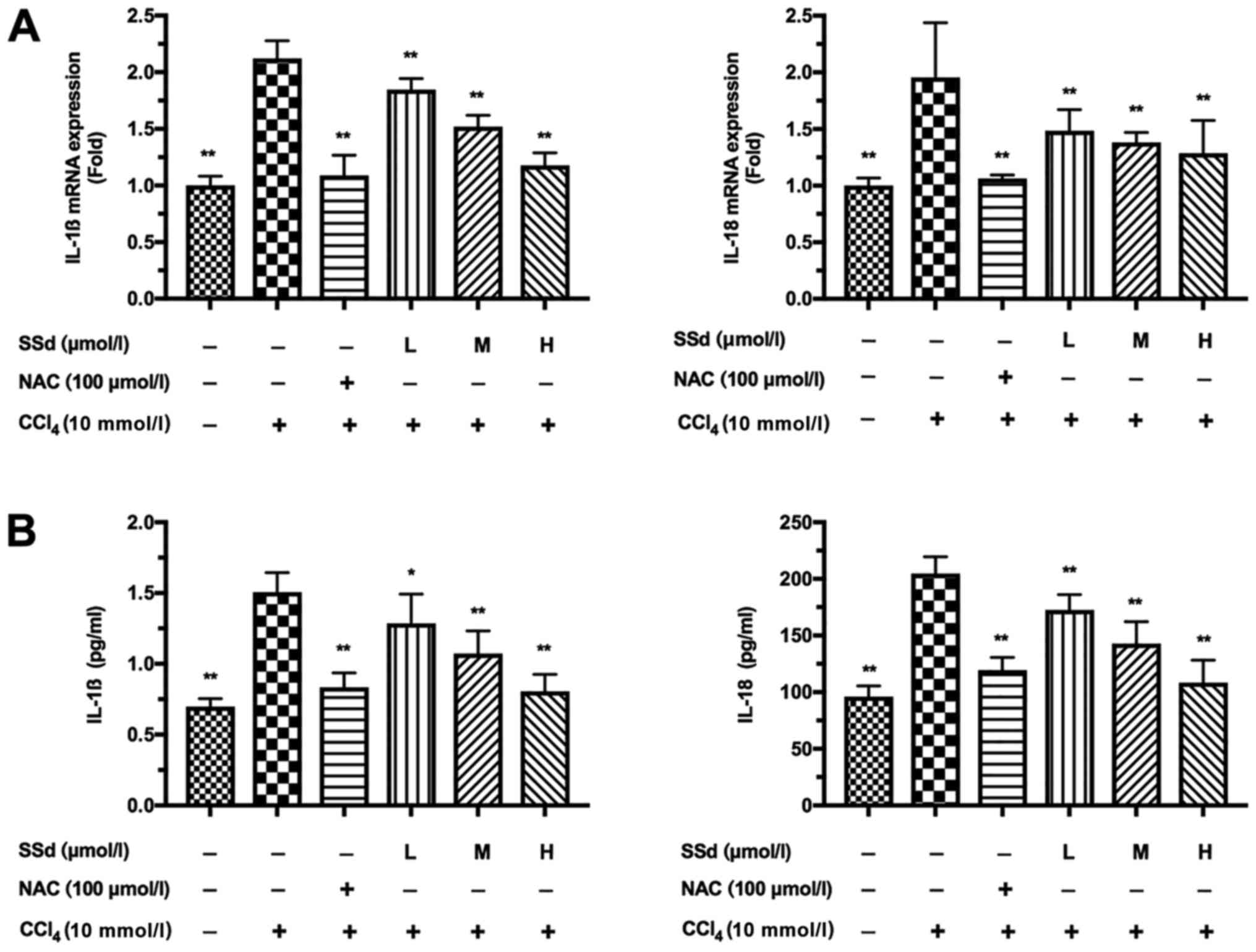|
1
|
Zhao P, Qi C, Wang G, Dai X and Hou X:
Enrichment and purification of total flavonoids from Cortex
Juglandis Mandshuricae extracts and their suppressive effect on
carbon tetrachloride-induced hepatic injury in Mice. J Chromatogr B
Analyt Technol Biomed Life Sci. 1007:8–17. 2015. View Article : Google Scholar : PubMed/NCBI
|
|
2
|
Tuñón MJ, Miguel San B, Crespo I, Jorquera
F, Santamaria E, Alvarez M, Prieto J and González-Gallego J:
Melatonin attenuates apoptotic liver damage in fulminant hepatic
failure induced by the rabbit hemorrhagic disease virus. J Pineal
Res. 50:38–45. 2011. View Article : Google Scholar : PubMed/NCBI
|
|
3
|
Auzinger G and Wendon J: Intensive care
management of acute liver failure. Curr Opin Crit Care. 14:179–188.
2008. View Article : Google Scholar : PubMed/NCBI
|
|
4
|
Assayed ME, Khalaf AA and Salem HA:
Protective effects of garlic extract and vitamin C against in vivo
cypermethrin-induced teratogenic effects in rat offspring. Food
Chem Toxicol. 48:3153–3158. 2010. View Article : Google Scholar : PubMed/NCBI
|
|
5
|
Kodai S, Takemura S, Minamiyama Y, Hai S,
Yamamoto S, Kubo S, Yoshida Y, Niki E, Okada S, Hirohashi K and
Suehiro S: S-allyl cysteine prevents CCl(4)-induced acute liver
injury in rats. Free Radic Res. 41:489–497. 2007. View Article : Google Scholar : PubMed/NCBI
|
|
6
|
Recknagel RO, Glende EA Jr, Dolak JA and
Waller RL: Mechanisms of carbon tetrachloride toxicity. Pharmacol
Ther. 43:139–154. 1989. View Article : Google Scholar : PubMed/NCBI
|
|
7
|
Zelen I, Djurdjevic P, Popovic S,
Stojanovic M, Jakovljevic V, Radivojevic S, Baskic D and
Arsenijevic N: Antioxidant enzymes activities and plasma levels of
oxidative stress markers in B-chronic lymphocytic leukemia
patients. J BUON. 15:330–336. 2010.PubMed/NCBI
|
|
8
|
Pan CW, Pan ZZ, Hu JJ, Chen WL, Zhou GY,
Lin W, Jin LX and Xu CL: Mangiferin alleviates lipopolysaccharide
and D-galactosamine-induced acute liver injury by activating the
Nrf2 pathway and inhibiting NLRP3 inflammasome activation. Eur J
Pharmacol. 770:85–91. 2016. View Article : Google Scholar : PubMed/NCBI
|
|
9
|
Keyel PA: How is inflammation initiated?
Individual influences of IL-1, IL-18 and HMGB1. Cytokine.
69:136–145. 2014. View Article : Google Scholar : PubMed/NCBI
|
|
10
|
Arteel G, Marsano L, Mendez C, Bentley F
and McClain CJ: Advances in alcoholic liver disease. Best Pract Res
Clin Gastroenterol. 17:625–647. 2003. View Article : Google Scholar : PubMed/NCBI
|
|
11
|
Neuman MG: Cytokines-central factors in
alcoholic liver disease. Alcohol Res Health. 27:307–316.
2003.PubMed/NCBI
|
|
12
|
Petrasek J, Bala S, Csak T, Lippai D,
Kodys K, Menashy V, Barrieau M, Min SY, Kurt-Jones EA and Szabo G:
IL-1 receptor antagonist ameliorates inflammasome-dependent
alcoholic steatohepatitis in mice. J Clin Invest. 122:3476–3489.
2012. View
Article : Google Scholar : PubMed/NCBI
|
|
13
|
Zhu P, Duan L, Chen J, Xiong A, Xu Q,
Zhang H, Zheng F, Tan Z, Gong F and Fang M: Gene silencing of NALP3
protects against liver ischemia-reperfusion injury in mice. Hum
Gene Ther. 22:853–864. 2011. View Article : Google Scholar : PubMed/NCBI
|
|
14
|
Zhang F, Wang X, Qiu X, Wang J, Fang H,
Wang Z, Sun Y and Xia Z: The protective effect of Esculentoside A
on experimental acute liver injury in mice. PLoS One.
9:e1131072014. View Article : Google Scholar : PubMed/NCBI
|
|
15
|
Lim DW, Kim H, Park JY, Kim JE, Moon JY,
Park SD and Park WH: Amomum cardamomum L. ethyl acetate fraction
protects against carbon tetrachloride-induced liver injury via an
antioxidant mechanism in rats. BMC Complement Altern Med.
16:1552016. View Article : Google Scholar : PubMed/NCBI
|
|
16
|
Chiu YW, Chao PY, Tsai CC, Chiou HL, Liu
YC, Hung CC, Shih HC, Lai TJ and Liu JY: Ocimum gratissimum is
effective in prevention against liver fibrosis in vivo and in
vitro. Am J Chin Med. 42:833–852. 2014. View Article : Google Scholar : PubMed/NCBI
|
|
17
|
Chan CC, Lee KC, Huang YH, Chou CK, Lin HC
and Lee FY: Regulation by resveratrol of the cellular factors
mediating liver damage and regeneration after acute toxic liver
injury. J Gastroenterol Hepatol. 29:603–613. 2014. View Article : Google Scholar : PubMed/NCBI
|
|
18
|
Zhang JQ, Shi L, Xu XN, Huang SC, Lu B, Ji
LL and Wang ZT: Therapeutic detoxification of quercetin against
carbon tetrachloride-induced acute liver injury in mice and its
mechanism. J Zhejiang Univ Sci B. 15:1039–1047. 2014. View Article : Google Scholar : PubMed/NCBI
|
|
19
|
Lee CH, Wang JD and Chen PC: Risk of liver
injury associated with Chinese herbal products containing radix
bupleuri in 639,779 patients with hepatitis B virus infection. PLoS
One. 6:e160642011. View Article : Google Scholar : PubMed/NCBI
|
|
20
|
Wong VK, Zhang MM, Zhou H, Lam KY, Chan
PL, Law CK, Yue PY and Liu L: Saikosaponin-d enhances the
anticancer potency of TNF-α via overcoming its undesirable response
of activating NF-Kappa B signalling in cancer cells. Evid Based
Complement Alternat Med. 2013:7452952013. View Article : Google Scholar : PubMed/NCBI
|
|
21
|
Chen L, Zhang F, Kong D, Zhu X, Chen W,
Wang A and Zheng S: Saikosaponin D disrupts platelet-derived growth
factor-β receptor/p38 pathway leading to mitochondrial apoptosis in
human LO2 hepatocyte cells: A potential mechanism of
hepatotoxicity. Chem Biol Interact. 206:76–82. 2013. View Article : Google Scholar : PubMed/NCBI
|
|
22
|
Fan J, Li X, Li P, Li N, Wang T, Shen H,
Siow Y, Choy P and Gong Y: Saikosaponin-d attenuates the
development of liver fibrosis by preventing hepatocyte injury.
Biochem Cell Biol. 85:189–195. 2007. View Article : Google Scholar : PubMed/NCBI
|
|
23
|
Lu CN, Yuan ZG, Zhang XL, Yan R, Zhao YQ,
Liao M and Chen JX: Saikosaponin a and its epimer saikosaponin d
exhibit anti-inflammatory activity by suppressing activation of
NF-κB signaling pathway. Int Immunopharmacol. 14:121–126. 2012.
View Article : Google Scholar : PubMed/NCBI
|
|
24
|
Wang HW, Liu M, Zhong TD and Fang XM:
Saikosaponin-d attenuates ventilator-induced lung injury in rats.
Int J Clin Exp Med. 8:15137–4512. 2015.PubMed/NCBI
|
|
25
|
Lu Q, Yang L, Zhao HY, Jiang JG and Xu XL:
Protective effect of compounds from the flowers of Citrus aurantium
L. var. amara Engl against carbon tetrachloride-induced hepatocyte
injury. Food Chem Toxicol. 62:432–435. 2013. View Article : Google Scholar : PubMed/NCBI
|
|
26
|
Han WJ, Shi HB, Shi HL, Song JY, Ren F,
Duan ZP and Chen Y: Augmenter of liver regeneration promotes the
proliferation of HL-7702 cells in carbon tetrachloride-induced
acute liver injury via increasing autophag. Zhonghua Gan Zang Bing
Za Zhi. 24:761–766. 2016.(In Chinese). PubMed/NCBI
|
|
27
|
DeNicola GM, Karreth FA, Humpton TJ,
Gopinathan A, Wei C, Frese K, Mangal D, Yu KH, Yeo CJ, Calhoun ES,
et al: Oncogene-induced Nrf2 transcription promotes ROS
detoxification and tumorigenesis. Nature. 475:106–109. 2011.
View Article : Google Scholar : PubMed/NCBI
|
|
28
|
Schroder K and Tschopp J: The
inflammasomes. Cell. 140:821–832. 2010. View Article : Google Scholar : PubMed/NCBI
|
|
29
|
Li X, Li X, Lu J, Huang Y, Lv L, Luan Y,
Liu R and Sun R: Saikosaponins induced hepatotoxicity in mice via
lipid metabolism dysregulation and oxidative stress: A proteomic
study. BMC Complement Altern Med. 17:2192017. View Article : Google Scholar : PubMed/NCBI
|
|
30
|
Zhao L, Zhang H, Bao J, Liu J and Ji Z:
Saikosaponin-d protects renal tubular epithelial cell against high
glucose induced injury through modulation of SIRT3. Int J Clin Exp
Med. 8:6472–6481. 2015.PubMed/NCBI
|
|
31
|
Yao M, Yang J, Cao L, Zhang L, Qu S and
Gao H: Saikosaponind inhibits proliferation of DU145 human prostate
cancer cells by inducing apoptosis and arresting the cell cycle at
G0/G1 phase. Mol Med Rep. 10:365–372. 2014. View Article : Google Scholar : PubMed/NCBI
|
|
32
|
Kadiiska MB, Gladen BC, Baird DD, Germolec
D, Graham LB, Parker CE, Nyska A, Wachsman JT, Ames BN, Basu S, et
al: Biomarkers of oxidative stress study II: Are oxidation products
of lipids, proteins, and DNA markers of CCl4 poisoning? Free Radic
Biol Med. 38:698–710. 2005. View Article : Google Scholar : PubMed/NCBI
|
|
33
|
Alfadda AA and Sallam RM: Reactive oxygen
species in health and disease. J Biomed Biotechnol.
2012:9364862012. View Article : Google Scholar : PubMed/NCBI
|
|
34
|
Brüne B, Dehne N, Grossmann N, Jung M,
Namgaladze D, Schmid T, von Knethen A and Weigert A: Redox control
of inflammation in macrophages. Antioxid Redox Signal. 19:595–637.
2013. View Article : Google Scholar : PubMed/NCBI
|
|
35
|
Kim WR, Flamm SL, Di Bisceglie AM and
Bodenheimer HC: Public Policy Committee of the American Association
for the Study of Liver Disease: Serum activity of alanine
aminotransferase (ALT) as an indicator of health and disease.
Hepatology. 47:1363–1370. 2008. View Article : Google Scholar : PubMed/NCBI
|
|
36
|
Hoek JB and Pastorino JG: Ethanol,
oxidative stress, and cytokine-induced liver cell injury. Alcohol.
27:63–68. 2002. View Article : Google Scholar : PubMed/NCBI
|
|
37
|
Weber LW, Boll M and Stampfl A:
Hepatotoxicity and mechanism of action of haloalkanes: carbon
tetrachloride as a toxicological model. Crit Rev Toxicol.
33:105–136. 2003. View Article : Google Scholar : PubMed/NCBI
|
|
38
|
Cheng N, Ren N, Gao H, Lei X, Zheng J and
Cao W: Antioxidant and hepatoprotective effects of Schisandra
chinensis pollen extract on CCl4-induced acute liver damage in
mice. Food Chem Toxicol. 55:234–240. 2013. View Article : Google Scholar : PubMed/NCBI
|
|
39
|
Tirkey N, Pilkhwal S, Kuhad A and Chopra
K: Hesperidin, a citrus bioflavonoid, decreases the oxidative
stress produced by carbon tetrachloride in rat liver and kidney.
BMC Pharmacol. 5:22005. View Article : Google Scholar : PubMed/NCBI
|
|
40
|
Dinarello CA: Immunological and
inflammatory functions of the interleukin-1 family. Annu Rev
Immunol. 27:519–550. 2009. View Article : Google Scholar : PubMed/NCBI
|
|
41
|
Davis BK, Wen H and Ting JP: The
inflammasome NLRs in immunity, inflammation, and associated
diseases. Annu Rev Immunol. 29:707–735. 2011. View Article : Google Scholar : PubMed/NCBI
|
|
42
|
Petrilli V, Papin S, Dostert C, Mayor A,
Martinon F and Tschopp J: Activation of the NALP3 inflammasome is
triggered by low intracellular potassium concentration. Cell Death
Differ. 14:1583–1589. 2007. View Article : Google Scholar : PubMed/NCBI
|
|
43
|
Franchi L, Eigenbrod T, Muñoz-Planillo R
and Nuñez G: The inflammasome: A caspase-1-activation platform that
regulates immune responses and disease pathogenesis. Nat Immunol.
10:241–247. 2009. View Article : Google Scholar : PubMed/NCBI
|
|
44
|
Yang H, Antoine DJ, Andersson U and Tracey
KJ: The many faces of HMGB1: Molecular structure-functional
activity in inflammation, apoptosis, and chemotaxis. J Leukoc Biol.
93:865–873. 2013. View Article : Google Scholar : PubMed/NCBI
|
|
45
|
Chen Q, Yin YX, Wei J, Tong M, Shen F,
Zhao M and Chamley L: Increased expression of high mobility group
box 1 (HMGB1) in the cytoplasm of placental syncytiotrophoblast
from preeclamptic placentae. Cytokine. 85:30–36. 2016. View Article : Google Scholar : PubMed/NCBI
|
|
46
|
Zhu L, Zhang Z, Zhang L, Shi Y, Qi J,
Chang A, Gao J, Feng Y and Yang X: HMGB1-RAGE signaling pathway in
severe preeclampsia. Placenta. 36:1148–1152. 2015. View Article : Google Scholar : PubMed/NCBI
|
|
47
|
Imaeda AB, Watanabe A, Sohail MA, Mahmood
S, Mohamadnejad M, Sutterwala FS, Flavell RA and Mehal WZ:
Acetaminophen-induced hepatotoxicity in mice is dependent on Tlr9
and the Nalp3 inflammasome. J Clin Invest. 119:305–314.
2009.PubMed/NCBI
|
|
48
|
Artlett CM: The Role of the NLRP3
Inflammasome in Fibrosis. Open Rheumatol J. 6:80–86. 2012.
View Article : Google Scholar : PubMed/NCBI
|
|
49
|
Kim SJ and Lee SM: NLRP3 inflammasome
activation in D-galactosamine and lipopolysaccharide-induced acute
liver failure: Role of heme oxygenase-1. Free Radic Biol Med.
65:997–1004. 2013. View Article : Google Scholar : PubMed/NCBI
|
|
50
|
Gong Z, Zhou J, Zhao S, Tian C, Wang P, Xu
C, Chen Y, Cai W and Wu J: Chenodeoxycholic acid activates NLRP3
inflammasome and contributes to cholestatic liver fibrosis.
Oncotarget. 7:83951–83963. 2016. View Article : Google Scholar : PubMed/NCBI
|
|
51
|
Dostert C, Pétrilli V, Van Bruggen R,
Steele C, Mossman BT and Tschopp J: Innate immune activation
through Nalp3 inflammasome sensing of asbestos and silica. Science.
320:674–677. 2008. View Article : Google Scholar : PubMed/NCBI
|
|
52
|
Sayan M and Mossman BT: The NLRP3
inflammasome in pathogenic particle and fibre-associated lung
inflammation and diseases. Part Fibre Toxicol. 13:512016.
View Article : Google Scholar : PubMed/NCBI
|
|
53
|
Shen YC, Chou CJ, Wang YH, Chen CF, Chou
YC and Lu MK: Anti-inflammatory activity of the extracts from
mycelia of Antrodia camphorata cultured with water-soluble
fractions from five different Cinnamomum species. FEMS Microbiol
Lett. 231:137–43. 2004. View Article : Google Scholar : PubMed/NCBI
|
|
54
|
Jaeschke H: Reactive oxygen and mechanisms
of inflammatory liver injury. J Gastroenterol Hepatol. 15:718–724.
2000. View Article : Google Scholar : PubMed/NCBI
|
|
55
|
Wu SJ, Lin YH, Chu CC, Tsai YH and Chao
JC: Curcumin or saikosaponin a improves hepatic antioxidant
capacity and protects against CCl4-induced liver injury in rats. J
Med Food. 11:224–229. 2008. View Article : Google Scholar : PubMed/NCBI
|
|
56
|
Yu H, Zheng L, Yin L, Xu L, Qi Y, Han X,
Xu Y, Liu K and Peng J: Protective effects of the total saponins
from Dioscorea nipponica Makino against carbon
tetrachloride-induced liver injury in mice through suppression of
apoptosis and inflammation. Int Immunopharmacol. 19:233–244. 2014.
View Article : Google Scholar : PubMed/NCBI
|
|
57
|
Dang SS, Wang BF, Cheng YA, Song P, Liu ZG
and Li ZF: Inhibitory effects of saikosaponin-d on CCl4-induced
hepatic fibrogenesis in rats. World J Gastroenterol. 13:557–563.
2007. View Article : Google Scholar : PubMed/NCBI
|














